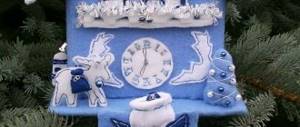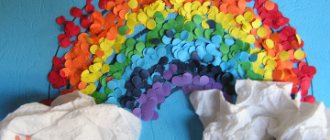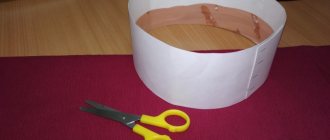III. Sundial in the schoolyard
After I found a sundial in Moscow, studied the structure of a sundial and its types, I decided to make my own sundial in the school yard. I decided to make one sundial in our schoolyard horizontal. As we know, one of the parts of such a clock is a gnomon, which is installed in the center at an angle equal to the latitude of the area. For Moscow, this angle is 56. But if you install a pin in the middle of the school yard, small children can run around and run into it. That is, the installation of such equipment would not be safe for schoolchildren. So I decided to make a removable gnomon. That is, attach it to the board, it will be constantly stored in the teacher’s office, and if necessary, under the guidance of the teacher, it can be installed and the time checked. But then, just walking in the yard, children without a gnomon will not be able to tell the time. That is, we need another sundial, where the person himself acts as a gnomon. As we know, this is an analemmatic clock.
My two-scale clock.
I came up with a new type of sundial that I had never seen before. This is a two-scale sundial.
In Moscow, from October to April the weather is mostly cloudy and the sun rarely comes out. And from November to March the school yard is covered with snow. Thus, during these months the use of sundials is irrelevant. On the other hand, in the summer all the children go on vacation, and no one plays in the school yard. That is, even in the summer months, sundials are not particularly needed. But on warm, sunny days in May or September, schoolchildren love to run out into the yard during breaks and walk there after classes. Children from the extended day group also spend a lot of time outside. These days, physical education classes take place outside; Some teachers conduct practical work outdoors. It was at this time that a sundial in the yard would come into use. And since we have only two months of using the clock, we can not change the site to accommodate the person who decided to use the clock, but make two scales of different colors: one for May and one for September with their own markings. We began to implement this idea in our schoolyard.
Stages of making a sundial
- So, at first we looked closely at our school yard for a long time, choosing a place that was well lit by the sun throughout the day. Such a place was found near the elementary school building.
- On a sunny day in mid-May, on Saturday, we went out into the schoolyard. We have drawn the base of our sundial. To do this, we took a thick thread, tied a pencil to it on one side, and chalk on the other. After that, we stuck a pencil into the ground and used chalk to draw 2 circles.
3. After we had 2 circles, we painted the space between them with white paint. This was the May scale.
4. After the 2 circles were filled in, we used a compass to mark all sides of the horizon.
5. Then we installed the gnomon so that its tip pointed to the south and put a dot in that place so that it would be clear how to place the gnomon. On a two-scale sundial, the gnomon, as we already know, is a person, so there we drew 2 feet that a person needs to stand on to find out the time. And every half hour we made marks.
6. After the Numbers were marked, we decided to decorate the clock with pictograms according to the daily routine. We drew pictograms using stencils of our own making, and then filled them with paint and graffiti spray cans.
7. Thus, the horizontal sundial was ready. And on the two-scale sundial the 1st May scale was ready. We could complete the two-scale sundial only in September.
8. In mid-September, on a sunny day, we completed our sundial. Thus, a September scale appeared on our two-scale sundial.
9. So that schoolchildren would understand how to use my sundial, I made a sign with detailed instructions.
And we were very pleased to see that schoolchildren come up to the clock, are interested in it and tell the time by it.
Varieties of sundials
Attempts to introduce a classification of sundials began in Ancient Rome. The then famous mechanic and architect Vitruvius described about three dozen of their types. In terms of sundial design, they differ, firstly, in orientation, and secondly, in the shape of the gnomon and dial.
Polar clock with horizontal dial
The most common sundial at the moment is the polar gnomon clock. In this type of watch, the gnomon is located parallel to the axis of rotation of the earth and is oriented in the direction of the polar star. The angle of inclination of the gnomon φ is equal to the latitude of the location of the sundial, respectively, at the poles the gnomon will be located vertically, and at the equator horizontally. This sundial is often also called a park sundial. They can be placed on any flat surface of a suburban area or park, not shaded by trees or other buildings.
Today, the most common sundial is with a polar gnomon (pointer). It is located parallel to the earth's rotation axis and is oriented towards the North Star from the constellation Ursa Minor, located near the North Pole. The angle of inclination of the gnomon is equal to the latitude of the location of the clock: vertically - at the poles, horizontally - at the equator. This type of sundial is also called a park sundial. They are convenient to place on any unshaded, flat surface.
Polar with vertical dial
Such clocks are mainly installed on the facades of buildings. Magnificent architectural monuments with an ancient sundial have been preserved. If there is strong shade by trees, placing them on the façade is the optimal solution. It is best when the facade is located strictly to the South. If the building deviates from the cardinal directions, then additional calculations should be made to take into account the angle of deviation.
This is a polar clock with a polar gnomon axis located on the dial, parallel to the plane of the equator. The dial is divided into 24 equal parts. The shadow indicating the time moves at a speed of 15 degrees per hour. If positioned correctly (gnomon angle = latitude of the area), this watch will be universal.
Taking into account the winter location of the Sun (below the equator plane), time readings in winter are read in the opposite direction, and the time scale of the opposite side is numbered counterclockwise.
This is a polar clock, in which the gnomon and dial are located parallel to the axis of rotation of the planet. The design has one drawback - the limited range of displayed time (from 7 to 17 hours). This is eliminated by changing the angle of the dial (to the east or to the west), which allows you to expand the range of morning and evening time. A gnomon can be a rod and plate perpendicular to the plane of the dial. It is good to put some phrase, drawing or sign on the plate.
Armillary sphere
This variety combines the advantages of equatorial and polar sundials, but without their disadvantages. The same dial shows time all year round in a wide range of values. The time scale is located on a strip lying in the equatorial plane, as in an equatorial clock. An armillary sundial can also act as a calendar, demonstrating the declination of the Sun (usually for the moments when the star enters a certain zodiac constellation).
Vertical sundial, analemmatic
One of the most ancient types of sundials are those in which the observer himself is a gnomon. The proportion of a person's height to the length of his feet is approximately 1:6. The angle of the Sun is determined by the length of the shadow. This takes into account that the shadow is cast in different directions at different times of the year, except for midday, when it falls due north. The role of the dial is an ellipse lying in a horizontal plane. In the center of this ellipse is the marking of the seasons. The gnomon is installed at the right time in the right place, allowing you to determine the true time. Everyone, if desired, has the opportunity to determine time with their own shadow.
It is curious that if a polar gnomon is added to the dial, then when the readings of the two gnomons are combined, the orientation of the watch will be reduced to this displacement.
There are two subspecies of this variety - cylindrical clock and hemicycle. Cylindrical ones are a vertical cylinder-dial and a gnomon horizontally fixed in the upper part. The horizontal gnomon pointer is fixed on a rotating stand that rotates along the cylinder axis to the position of the current month. The shadow lies vertically, indicating a temporary marking. Since the clock shows time depending on the altitude of the Sun, which is the same twice during daylight hours, the same clock shows both morning and evening time.
The hemicycle works on the principle of a sundial with a polar gnomon, indicating the true time and declination of the star. The dial is divided into equal time intervals. Hemicycles first appeared in Ancient Greece, where gnomonics reached a high level of development.
Equatorial sundial: DIY production
This is a very simple sundial to make - this is due to the fact that the divisions of its dial are the same and amount to 15 degrees, which corresponds to one hour. In principle, this is where everything simple in this watch ends and the difficulties begin - a watch of this type must be installed correctly, which in itself is difficult. Such a clock must be installed simultaneously in two planes.
- Orientation relative to the cardinal points - the plane of the dial or the gnomon itself must be directed to the true pole of the earth. It does not coincide with the magnetic pole - the difference between them is about 7-8 degrees. By orienting the sundial by the compass, you will get a time error of within half an hour. In principle, this error can be eliminated using a regular clock - at exactly noon, the shadow of the gnomon will point to the true north pole. All you have to do is adjust the watch dial to it and that’s it.
- Orient the gnomon clearly in accordance with the axis of rotation of the Earth. Everything is simple here and for this task you can use a regular protractor. The angle of inclination of the sundial gnomon is equal to the latitude of your place of residence - you can determine the latitude using topographic maps or via the Internet. In general, this is not a problem today.
As for the actual production of equatorial sundials, everything is very simple. It is better to use a hard material like plastic for them. First you make a dial with a gnomon, then you think about how you can install it at an angle, but also orient it to the north, after which the clock will work. By the way, the angle of inclination of the gnomon can be easily adjusted with a protractor and rulers - the drawing tool has a special lock that allows you to set the desired angle between a pair of rulers. By the way, for our hemisphere, the clock should be pointed towards the true north pole, but if you make a clock while in the southern hemisphere, then the gnomon and dial should point towards the true south pole. In this case, the dial will be a little different - it will be a mirror image of a sundial for the northern hemisphere of the Earth.
You can see what a sundial can be like in this video.
Equatorial sundial
- Plywood or plastic is used as a base. A dial is drawn on it with divisions every 15 degrees.
- A metal pin or rod made of any strong material is fixed in the center of the dial.
- The clock must be set correctly. To do this, the dial is tilted using a stand. The angle of this inclination is calculated for each area individually: 90 degrees minus the degree of latitude of the area.
- After installing the dial, the sundial must be oriented to the area - point the clock hand to the north.
- It is worth remembering that such a sundial will only show time in certain seasons, and in winter, for example, it will not be unsuitable.
How to make a sundial with your own hands
The sundial is the oldest mechanism for telling time. A sundial is a simple device, but it contains the knowledge and observations of our ancient ancestors. Currently, sundials are used as landscape decorations. Using the example of a sundial, parents teach their children the structure of the solar system, and building a sundial with their own hands is a very exciting activity for our children, for example, while on the beach. When making a sundial, you need to know some points and features of its design, which we will talk about in this article.
What is a sundial made of?
A sundial consists of a pointer hand that casts a shadow (this hand is called a gnomon) and a sundial dial. Time on a sundial is determined by the shadow cast by the gnomon on the dial. Everything is simple, but there are some peculiarities. The dial of a sundial is divided into 24 hours, rather than 12 hours, as in conventional mechanical watches. The dial or gnomon must be tilted above the plane. The sundial does not take into account daylight saving time. The sundial only works in clear or partly cloudy weather during daylight hours. That's all the limitations of the sundial.
There are several types of sundials. Let's deal with them in order.
Horizontal sundial.
Horizontal sundials can be made directly on the sand on the beach.
First we need to know two things: what latitude we are at and where north is. If the second part can be installed by selection, then with the first you will have to be prepared. So, we have a compass and we know our latitude (St. Petersburg - 60, Moscow - 55, Nizhny Novgorod - 56, Ekaterinburg - 56, Sochi - 43, Rostov-on-Don - 47, Novosibirsk - 55, Vladivostok - 43 degrees north latitude). If we make a sundial dial on a portable surface, we draw a circle and divide it into 24 parts. If we make a sundial on the ground, draw a circle, insert a stick (gnomon) into the center of the circle and tilt it north so that the angle between the surface of the earth and the gnomon is equal to our latitude, draw a line from the lower end of the gnomon exactly north - this will be 12 hours of the day astronomical time. We draw the remaining lines, dividing the entire circle into 24 equal sectors. Each sector of the sundial is equal to 15 degrees. An ambush awaits us here. After competently delineating the dial and tilting the gnomon, the time shown by the sundial may differ from the time shown by local television. The problem lies in maternity time and time zones, which were artificially created for convenience. A portable dial will easily solve this problem by simply turning it until the time is correct. With a clock drawn on sand a little more complicated, this point must be taken into account when starting to paint the dial. For example, you can postpone marking the dial until 12 o'clock, when we will determine the north without a compass and accurately draw the main axis of the dial of our sundial. If you have no time to wait, and creativity is bursting out of you, draw a draft sundial dial and adjust your dial to the error that you have.
In our latitudes, sundials operate during the height of summer from 8 am to 8 pm, so it is almost pointless to calculate numbers between these values. Because of this, the base of the gnomon is often moved downward on a round dial.
Equatorial sundial.
An equatorial sundial is the same horizontal clock, only the gnomon is set clearly vertically, and the dial itself is inclined to the surface of the earth at the angle of latitude where such a clock is installed.
Vertical sundial.
Vertical sundials are usually mounted on the walls of houses. The same tilted gnomon and dial marked at 15 degrees.
Usually in cities they make a mixed type of sundial, i.e. The dial is tilted half an angle, and the gnomon is tilted half an angle. Such a construction of a sundial looks more impressive, in fact, that’s why they are made.
Building a sundial with your own hands will really captivate your child and, in addition, expand his horizons.
Interesting facts about sundials
Sundials, unlike wristwatches, show real solar time, while time invented by man is largely simplified. The sundial clearly shows noon. The interval between two noons is called a solar day. A sundial is directly dependent on the sun, and it is almost impossible to design a mechanical unit oriented towards the sun. Time, invented by man, is not only not accurate, but also constant, which excludes this very accuracy.
Thus, the gnomon is one of the main parts of the sundial. It looks like a beautiful design. Observing the gnomon allows you to find out the exact time depending on the sun, that is, the true one.
Is it possible to buy a sundial?
Today you can see many different models of sundials on sale. Unfortunately, many of them perform a purely decorative function and are not suitable for accurate time measurements. Personally, I was lucky enough to see such a model only once, with the help of which you can actually determine time.
When purchasing a “working” sundial, the first thing you should pay attention to is what type it is. The equatorial type of sundial, as mentioned earlier, is universal, which means that there is a possibility that they can be installed normally in any area and ensure correct operation
Such watches should be equipped with a mechanism that allows you to adjust the tilt of the dial, and, if possible, a rotating scale, allowing you to use it in any location.
There are also companies that manufacture custom-made sundials, but their services, as far as I know, are very expensive.
Based on this, it seems to me that it is easier to make a sundial yourself from cardboard or plywood. In this case, a person will not only acquire a really working tool, but will also better understand the principles on which these watches work. And these principles are the fundamental thing of all methods of orientation by the Sun, stars and Moon, so necessary for travelers who consider the risks of emergency situations and study ways to overcome them.
To summarize all of the above, several points can be noted.
For a person who finds himself in the wild, a sundial and a gnomon, in particular, will allow him to navigate the area. In this regard, a portable sundial is a more universal tool, as it makes it possible to find the approximate location of the cardinal directions at any moment of the day, if the time and coordinates of the area are known, and the Sun is not hidden by clouds. With a stationary sundial everything is even simpler: they make it possible to navigate in cloudy weather and even at night, since, as a rule, they are oriented strictly to the cardinal points.
Sundial functions such as time and date are not so necessary in tourism and emergency survival situations. At least, I have never heard of anyone being seriously injured without knowing the calendar day or local time. If, however, you still need to navigate in time by the Sun, as for me, it is easier to do this if you know the cardinal directions and the direction to the Sun at the moment. Yes, the result will not be very accurate, and in low latitudes this method will be of little help, however, you also won’t have to carry a bulky sundial with you or waste time building one on the ground from scrap materials.
If, nevertheless, there is an urgent need for a sundial, then you should orient it not by a compass, but by the North Star or by the cardinal directions determined using a gnomon. As mentioned earlier, the magnetic poles do not coincide with the geographic ones, and the area where the sundial is installed may be located in the zone of a magnetic anomaly. All this will not make it possible to correctly set the sundial using a magnetic compass.
The watch is skafis.
According to the story of Vitruvius, the Babylonian astronomer Berossus, who settled in the 6th century. BC e. on the island of Kos, introduced the Greeks to the Babylonian sundial, which had the shape of a spherical bowl - the so-called scaphis. This sundial was improved by Anaximander and Anaximenes. In the middle of the 18th century, during excavations in Italy, they found exactly the same instrument as described by Vitruvius. The ancient Greeks and Romans, like the Egyptians, divided the time period from sunrise to sunset into 12 hours, and therefore their hour (as a measure of time) was of different lengths depending on the time of year. The surface of the recess in the sundial and the “hour” lines on it were selected so that the end of the rod’s shadow indicated the hour. The angle at which the top of the stone is cut depends on the latitude of the place for which the watch is made. Subsequent geometers and astronomers (Eudoxus, Apollonius, Aristarchus) came up with various forms of sundials. Descriptions of such instruments have been preserved, bearing the strangest names according to their appearance. Sometimes the gnomon, casting a shadow, was located parallel to the axis of the earth.
Horizontal sundial.
| It is best to make such a clock motionless on the pillar of the astronomical platform. The main board with hour divisions is located horizontally. In the plane of the meridian, a metal plate with a straight beveled edge is fixed above this board along the line 0-12 o'clock, located in relation to the horizontal board of the clock at an angle equal to the latitude of the place. The shadow of this plate, falling on a horizontal surface, indicates solar time. Some difficulties may arise during the manufacture of the dial. The simplest method is shown in Fig. 60. A circle divided into 24 equal parts is placed on a horizontal surface; a vertical rod passes through the center of this circle, onto which another circle is mounted so that the rod also passes through its center. The upper circle is fixed at an angle equal to the latitude of the place. |
Straight AB
continue beyond the line
mn
.
Having installed the leg of the compass at point A
as the center, we draw a semicircle with a radius equal to leg
AC
.
the intersection of this curve with the continuation of straight line
BA
by
point
O. Through this point we draw a line pq
parallel to
mn
and, considering point
O
as the center, we draw a semicircle
pAq
.
The latter is divided into 12 equal parts, radii are drawn through the lines of these divisions and continue until they intersect with the line mn
.
We connect the intersections with straight lines to
point B. These straight lines on the surface of the dial indicate the hour divisions.
These same divisions are not difficult to find using trigonometry. Let x
there will be an angle formed by the edge of the shadow with the noon line;
— geographical latitude of the place; t
is the hour angle of the Sun.
Then using the formula: you can calculate the value of the angle x
for any value of
t
and place it on the dial from the 0-12 o'clock line.
| Fig.61 |
Using a similar technique, you can arrange a clock on a vertical plane. The beveled edge of the plate installed in the meridian plane must also be located along the axis of the world. The formula corresponding to the vertical plane will look like:
.
When installing this clock, you should carefully check the horizontalness of the board with a level.
In order for students to move from true solar time to standard time, it is necessary to have tables in the classroom that give the equation of time with an accuracy of 0.5 minutes and a correction for the transition from local mean time to standard time.
| Previous | Up | Next |
| Publications with keywords: astronomy education Publications with keywords: astronomy education |
| See also: All publications on the same topic >> |
Astrometry
—
Astronomical instruments
—
Astronomical education
—
Astrophysics
—
History of astronomy
—
Cosmonautics, space exploration
—
Amateur astronomy
—
Planets and the Solar System
—
The Sun
Types of sundials
Such watches can be of different types, but mainly there are three types:
- Equatorial. Their dial (cadran) is located parallel to the equator, and the part that casts the shadow - the gnomon), in the form of a metal rod, is parallel to the earth's axis. The markings on the dial of such a watch are every 15 degrees.
- Horizontal. In them, the plane of the frame is parallel to the horizon, and the gnomon is made in the form of a triangle, with the side inclined to the plane of the dial at an angle equal to the geographic latitude of the given area. The arrow is directed north, and divisions into sectors (hours) are made according to the formula. Such clocks show time all year round, but in winter and late autumn their readings are not entirely accurate.
- Vertical. Their dial is located vertically and is placed on the walls of buildings, pillars, fences and other vertical planes. The frame in them should be directed strictly south and should be perpendicular to the noon line or at an acute angle to it. The gnomon in such a sundial is fixed above the center of the dial and must be deflected by an angle equal to 90 degrees minus the latitude of the area.
Sundial: master class
Try making your own sundial with your child. This lesson will help you explain to your child in detail how to tell the time using such clocks, why they are designed this way, and how one type differs from another.
Equatorial clock
First of all, try to design an equatorial sundial with your own hands - the simplest one to make.
You don't need to calculate the number of hour divisions on the dial and the degree measure of each of them - you can find many frame templates on the Internet.
Before starting to draw the layout, calculate the length of the sides. In the image you see the angle α, which is calculated using the following formula: 90 degrees minus the degree measure of the geographic latitude in which you are located. Accordingly, the opposite angle will be equal to: 90 degrees minus the value of the angle α.
Choose an arbitrary value for side C - this will be the length of the sides of your dial.
The side of this layout is presented in the form of a right triangle. Therefore, knowing the hypotenuse (side C) and all the angles of the triangle, we can calculate the remaining sides using the following formulas: side A is equal to side C multiplied by the sine of angle α, and side B is equal to side C multiplied by the cosine of angle α.
Using the data obtained, draw a model of the device with your own hands on a sheet of the required size, cut it out and glue it together. In this case, any stick of the required diameter can serve as a gnomon. Simply make a hole in the desired location and position the gnomon perpendicular to the dial.
Place the sundial on the windowsill so that the gnomon points directly north. You can calculate the direction using a compass.
Horizontal clock
It is even easier to create a horizontal sundial with your own hands than an equatorial one. Choose a hard material so that it will be easy to draw the dial later: plastic, cardboard or thin wood.
Make a round or square dial.
Make a triangular gnomon. Before starting work, calculate its parameters: one angle should be equal to 90 degrees, and the other should be the latitude in which the watch is located.
Place the gnomon in the center of the dial.
Place the clock on the windowsill so that the lower extreme corner of the gnomon faces exactly south.
Take the watch. Every hour, mark the position of the shadow of the frame on the dial. After you have marked all 12 points, draw the dial with your own hands.
Once you've learned how to make a DIY tabletop sundial, try making a pocket sundial. The following video tutorial will help you with this.
https://youtube.com/watch?v=nPSVSRQTGdg
Horizontal clocks can be increased in size, decorated and used as a decorative element of your flowerbed or garden. For example, you can sculpt the gnomon and each number on the dial with your own hands and paint it to match the flowers growing around you. Or you can make a device based on a wooden cut - then the best decoration will be burning figured numbers into wood.
LiveInternetLiveInternet
There are many varieties of this ancient device for measuring time. But among all the variety of sundials ever used, the following types are distinguished as the main or classic ones:
- equatorial (in such sundials the plane of the frame (dial) is parallel to the equator, and the gnomon (the part that casts the shadow), usually a metal rod, is parallel to the earth's axis);
Equatorial sundial on the banks of the Thames (London, England)
— horizontal (the plane of the frame is parallel to the horizon plane, and the gnomon has the shape of a triangle, one of the sides of which is inclined to the plane of the frame at an angle equal to the latitude of the place where the clock is installed);
Horizontal sundial (Limassol, Cyprus)
— vertical (as the name suggests, the dial of such a watch is placed in a vertical plane, usually on the walls of buildings).
Wall sundial (Ely Cathedral, England)
We will make an equatorial type sundial, as it is the easiest to make. Due to the fact that the dial is installed parallel to the equator, and the sun moves almost uniformly across the celestial sphere, the shadow of the gnomon will shift by an angle of 15° every hour. Therefore, the hour divisions on the dial are applied in the same way as in a regular watch, only the marks need not 12, but 24. It is clear that the upper part of the dial is unlikely to be useful, except for residents of the Arctic, when the polar day comes and the sun will shine around the clock.
There is no need to draw the dial yourself; you can use ready-made templates - round or square (whichever you prefer):
| Dial-square sun-dial-square.jpg 393.7 KiB 53 Downloads Details… | Dial-circle sun-dial-circle.jpg 291.4 KiB 34 Downloads Details… |
Our task comes down to correctly orienting the sundial in space. The angle of inclination of the dial relative to the horizontal plane is determined as follows:
α=90°-φ,
where φ is geographic latitude. You can find out the latitude of your place of residence on a map or on Wikipedia.
And knowing the required angles, it is very simple to make an inclined stand for our sundial from cardboard or paper and then stick a printed dial on it or prepare a scan of the watch case with a printed image of the dial in a graphics editor.
Let's see how to calculate the dimensions of a sundial case.
We know the dimensions of the dial template. The side of the case is a right triangle. Thus, we know the length of the hypotenuse C and the angles of the triangle, and the lengths of the legs A and B are calculated using trigonometric formulas:
A=C×sinα
B=C×cosα
All that remains is to draw the development according to the obtained dimensions, it is possible even without the side walls.
I made a case with an opening back cover (I’ll explain why below):
No matter what you do, you still end up with a box.
Well, now you need to install a gnomon in the center of the dial. To do this, you can use any rod of suitable size (for example, a plastic straw from a juice bag). You can also make it from cardboard or paper:
— cut out a rectangular strip 60 mm wide (we determine the length empirically, by eye, so that when folded, you get a dense tube with a diameter of about 5-6 mm with a small hole);
— glue double-sided tape to one edge and roll up the tube;
— cut out another rectangular strip 15-20 mm wide and also roll it into a tube with a diameter that matches the diameter of the hole in the first tube;
- cut off part of the first tube at a distance of 10 mm from the edge (this will be something like a nut)
and connect the parts;
— we fix the gnomon on the dial, fixing it on the reverse side with a “nut” (this is where the opening lid comes in handy).
The sundial is ready. Now, for them to work correctly, you need to place them in a sunny place (on a windowsill, on a balcony, etc.) so that the gnomon “looks” north (we determine the direction using a compass).
Of course, you should not expect an exact coincidence of the readings of such a sundial with the readings of ordinary watches. Firstly, sundials that show true solar time do not take into account the standard time in a particular area. Secondly, we should not forget that the magnetic and geographic poles of the Earth have a discrepancy, and the fact that we oriented the watch along the magnetic pole will also introduce some error.
And finally, the main point that you also have to take into account is that the equatorial clock works only during the period between the days of the spring and autumn equinox. The rest of the time, the upper surface of the frame will be in the shadow. But the day of the spring equinox in the northern hemisphere is soon, so the wait will not be long. There is just enough time to make a sundial with your own hands and set it up to work.
Successful experiments to you! And see you again at KARTONKINO.ru.
SOURCE










